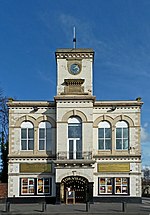Knottingley railway station
DfT Category F1 stationsFormer Great Northern Railway stationsFormer Lancashire and Yorkshire Railway stationsKnottingleyNorthern franchise railway stations ... and 3 more
Railway stations in Great Britain opened in 1848Railway stations in WakefieldUse British English from December 2016

Knottingley railway station serves the town of Knottingley in West Yorkshire, England. It lies on the Pontefract Line, operated by Northern, and is 16 miles (26 km) south east of Leeds railway station. The station is the final one in West Yorkshire before the North Yorkshire border and most services terminate (or start) there.
Excerpt from the Wikipedia article Knottingley railway station (License: CC BY-SA 3.0, Authors, Images).Knottingley railway station
Pontefract Road, Wakefield
Geographical coordinates (GPS) Address Nearby Places Show on map
Geographical coordinates (GPS)
| Latitude | Longitude |
|---|---|
| N 53.7065 ° | E -1.259 ° |
Address
Pontefract Road
WF11 8RJ Wakefield
England, United Kingdom
Open on Google Maps








